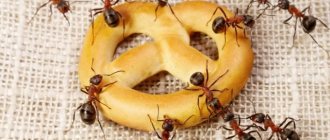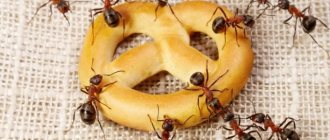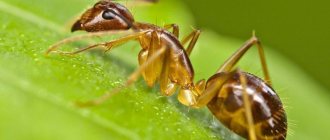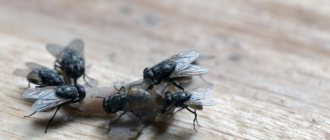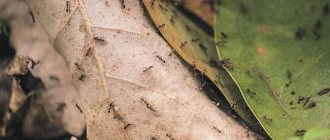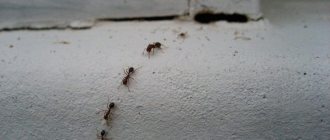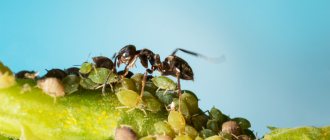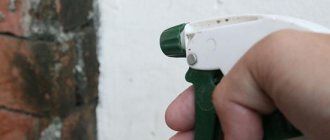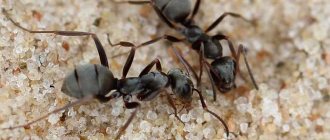The true reason for the antipathy of ants to millet is unknown, but the method of fighting ants with the help of millet is quite popular. There are several ways to use this cereal to expel forest and garden ants from your plot of land. In addition, millet can also be used against house ants.
It is not known for certain why ants are afraid of millet, but the fact remains: if you cover their paths and anthills with this grain, the number of ants in the area will sharply decrease. You can destroy ants using millet in an apartment, only the method of use in this case will be slightly different.
Millet is a grain made from millet, a valuable nutritious grain. But all types of ants - forest, garden, domestic - do not like it. Several versions have been put forward to explain this:
- In shape and size, millet grains are similar to ant eggs. So the ants take it for their dead eggs. The abundance of dead eggs frightens them and forces them to find a more suitable place to build an anthill, where the larvae would not die at the stage of development in the egg.
- The second version is partly similar to the first: the ants mistake the grains for eggs, so they take them to the anthill. After the first rain, the cereal swells, closing all exits and entrances, which leads to the death of the queen (queen) and most of the working individuals.
- The smell of wheat is unpleasant or is associated with something threatening for insects. Whether this is true or not, where millet was scattered, the ants soon disappear. Although they may appear again after some time. Perhaps they are simply clearing their territory of millet.
- Millet scattered on the surface of an anthill gets inside without the participation of ants. The streamlined shape of the grains facilitates its unhindered rolling inside the anthill along all entrances. Eventually, the grain completely fills the inner chambers of the nesting chamber, where the larvae and the queen (the queen who lays eggs) are located. It is impossible for insects to remove all the grains from the anthill, and it is also impossible to get out of the anthill, so the bulk of the ants die, and the survivors leave.
- Millet is used as food for ants and the queen, and when the grain swells in the stomach, the insects die.
- Millet attracts small birds to the garden, which willingly peck the grains along with insects. Ants have a protective coloring, and the bright grain is clearly visible to birds. Probably, in this way the millet “tells” the birds the location of the ants.
- The grain kernels end up in the lower layers of the anthill, where it is constantly damp and dark. In such conditions, soil fungi begin to quickly develop on the cereal, which pose a danger to ant larvae. The larvae begin to die, and the ants, in panic, leave the unsuitable place, going in search of a new one.
There have been no scientific studies on the effects of millet on ants. However, the cereal poured onto the nest or next to it soon disappeared, and with it the ants. It also happened that the ants disappeared only for a while, but after several days they appeared again.
The method of using millet is completely safe for plants, soil, animals and humans. The kernels of this cereal contain only useful substances - it is all the more surprising that millet can cause so much trouble for ants.
How ants harm the garden
At first glance, the interests of ants and humans overlap little in the garden: humans grow vegetables and fruits, ants build anthills and feed their offspring. However, it often happens that the homes of these insects are located in beds, flower gardens and under trees, which in itself is inconvenient for gardeners. But first of all, this harms the root system of plants, especially young shoots, and ants sometimes eat ripe berries and vegetables. The main danger to the garden is aphids, which suck the juice from the stems, buds and leaves of plants.
Ants breed aphids, which are dangerous for cultivated plants.
In addition, aphid secretions are an excellent breeding ground for many pathogenic fungi, such as black sooty mildew. But it is the ants who breed these tiny pests. Thus, ants cause damage to your area both directly and indirectly.
Advantages and disadvantages of the method
The most important advantage of the method is its naturalness. Cereals, unlike chemical insecticides, do not harm plants in the garden.
- Other advantages:
- low cost;
- availability of ingredients;
- ease of preparation;
- It is also used as prophylaxis.
One of the disadvantages of the method is its dependence on weather conditions . On a rainy day, the toxic treat will simply be washed away by the rainfall. The use of millet is effective in dry weather. Another disadvantage is related to the use of dry cereals - you need to wait for the effect. Baits with sweeteners, flavored with boron, act faster.
Entomologists have discovered that male ants, unlike females, emerge from unfertilized eggs, i.e., they have only the maternal set of chromosomes.
Why millet
The very idea of fighting ants with millet may at first seem unexpected and very strange. After all, there is still no clear explanation of the mechanism of its effect. There are no authoritative scientific studies proving the harm of millet cereals to the ant organism. There are only a few different assumptions.
- Harmful to digestion. One of the simplest and most obvious versions is that millet is harmful to the digestion of ants. Namely, it is assumed that the eaten millet swells in the intestines of the insect to sizes incompatible with life and almost tears it apart. It is not very clear whether for this the ant should eat the whole millet grain or just a part, which casts doubt on the version. Some believe that semolina, which is known to swell greatly when soaked, also gives a similar effect.
- Harmful to ant passages. Another version says that ants mistake millet grains for their eggs (due to external resemblance) and carry them to the anthill. And there, under the influence of increased soil moisture, the grains swell and clog the passages. The ants can neither leave nor enter, and the queen and offspring locked inside die of hunger. Or they leave their home to build a new, more comfortable home.
- Harm to the home. Another version, which is a variation on the previous theme, suggests that the grain softened in an anthill is not dangerous at all for passages. The thing is that mold quickly and easily develops on it, which then spreads throughout the anthill. Insects cannot cope with the fungus, and they have to leave their home and create a new one.
- Harm to the psyche. There is another assumption that sounds very fantastic. Some believe that ants mistake millet grains for their eggs - but not growing ones, but dead ones. This terrifies the insects and forces them to leave their homes in search of a safer home.
Nuances of indoor use
You can use millet cereal as a remedy for ants not only in the garden, but also in a country house and in a city apartment. In the same way, it is mixed with powdered sugar or soaked in super-sweetened water, and then laid out next to insect nests and along their paths. However, it is necessary to monitor small children and omnivorous pets in the house - millet should be placed in places inaccessible to them.
In addition, raw millet can begin to deteriorate - then it will turn into a breeding ground for pathogenic bacteria and fungi. Therefore, you need to update the bait in time and throw away spoiled cereals immediately. Moreover, if you manage to destroy domestic ants using millet, be sure to find their home and clean out both the softened millet and the ants’ food reserves.
How to use
Millet against ants in the country is used in its raw form, which only simplifies the process of getting rid of it. To do this, the cereal is scattered in places where there are large concentrations of individuals. Be sure to treat the anthill, as well as the main ant paths.
Important!
You should not use this method in the garden during heavy rains. The grain will simply be washed away, and the ants will not be able to reach it.
The use of millet in the fight against ants
If you need to get rid of garden ants as quickly as possible using millet, then you will have to make the taste of the famous cereal more attractive. For these purposes, you can try the following recipes:
- Add 150 g of regular powdered sugar to 0.5 kg of millet. Mix everything thoroughly so that every grain becomes sweet. Sprinkle the bait near the anthill.
- Millet pre-soaked in syrup helps a lot. To do this, dissolve 3 tbsp in 500 ml of warm water. l. sugar, jam or honey. Soak the millet in the prepared syrup for 15 minutes and place the sweet treat in the area near the anthills.
The disadvantages of this method include its short-term effect. Sometimes individuals return again after a few weeks. In this case, it will be necessary to re-treat the area and use additional repellents. It is allowed to plant plants nearby whose smell repels insects. Mint, lemon balm and tomatoes are effective for these purposes.
On a note!
Millet can also be used as a prophylactic. To do this, sprinkle cereals near berries, trees, and flowers several times a season.
Millet and semolina in the fight against ants
Millet groats are the peeled fruits of cultivated millet species.
Operating principle
The principle of action of millet on ants is not fully known. There are three theories:
- Insects mistake the grains for ant eggs and carry them to the nest, where the grains expand under the influence of humidity and clog the passages. As a result, the queen dies of starvation;
- After reaching the lower layers of the anthill, soil fungi settle on grains of millet under the influence of moisture. Such grains scare away ants and they leave the nest. Perhaps these fungi are dangerous for them, or maybe they just don’t like the smell;
- The most common theory is that ants eat millet, after a while it swells in their stomachs and the insects die. When the grains are brought to the queen, the same thing happens to her. This version is most applicable to semolina.
Semolina is obtained by grinding wheat grains
Application
Whatever is true, millet and semolina actually help against ants. The use of cereals is simple:
You can sprinkle semolina or millet throughout the area, paying special attention to ant paths, places near berry bushes, garden roses, and fruit trees. It’s great if you find an ant’s nest - you should put the most generous portion there. Sometimes ants can ignore grains
To make them more attractive to insects, semolina or millet is mixed with sugar, because ants love sweets: Take a glass of powdered sugar per kilogram of cereal, mix everything well; The millet is soaked in hot water for a couple of minutes (no longer needed, it should swell until the end only in the ants’ stomachs) and jam, jam, honey, syrup or molasses are added. The resulting mass is laid out near the nest. In principle, you can mix sweet ingredients with dry semolina.
You can try using a combination of cereals: for example, scatter dry semolina over the area and place sweet millet near the nest. It is better to fight pests in spring and early summer, when they have just woken up and have not had time to cause much damage to the area. To prevent birds from pecking the cereal, you can lightly sprinkle it with soil, leaves, dry pine needles, etc.
Ants raise aphids like cattle: they are attracted to the sweet secretions of pests
How this method works
When using any means of pest control, one should take into account the lifestyle of ants, the characteristics of their behavior and reproduction. After all, workers usually come to the surface in search of food, but the queen, who is responsible for procreation, usually does not leave the anthill. It is for this reason that killing worker ants is not a solution to this problem. To get rid of garden ants in the garden, it is necessary to fight the queen. How millet works in this situation, many will ask.
Millet from ants Why are ants afraid of millet, because the yellow grains do not have a specific smell at all. Opinions on this matter vary.
According to one version, wheat grains cause the death of the queen because, under the influence of moisture, they swell and clog the passages in the anthill, depriving the queen of the opportunity to feed.
Others believe that insects eat millet very well. Ants that have dined on grains will certainly die from the effects of grains swollen in their bodies, since the latter’s influence on the digestive system is inevitable.
There is a third opinion, according to which, due to constant dampness in the soil, soil fungi begin to appear on scattered wheat grains. The offending odor can influence ants, forcing them to leave the area.
It has not yet been possible to verify which of these variations coincides with reality. However, it is quite possible to get rid of “garden robbers” with the help of millet.
Other folk remedies
Borax solution
In the event that millet cereal or semolina do not help against ants or have stopped helping, domestic summer residents still have plenty of folk methods in their assortment. You can fight ants that have multiplied in an apartment, garden or greenhouse using substances that have a strong odor. To do this, insects are dispersed in the area of distribution:
- boric acid;
- cinnamon;
- lemon juice;
- cheap perfume;
- mustard powder;
- red pepper powder;
- kerosene;
- borax solution;
- nicotine water;
- vinegar.
To clear the area of rapidly multiplying insects, garlic arrows, anise and tomato leaves are left near their colonies. In gardens, frequent loosening and sprinkling of slaked lime or ash also helps. The effectiveness of a particular method depends on the type of insects that tolerate various means of combating them better or worse, air temperature, weather conditions, humidity and precipitation. To find the most effective method for a particular situation, you can alternate approaches, however, in an advanced situation with insects spreading indoors, it is better to call parasite control specialists.
Recipes and instructions for using millet against ants
Millet against ants has been used for quite a long time and each owner has his own super-effective recipe. Most often, this cereal is used raw. It simply fills up the anthill, the place of dislocation or frequent appearance of ants. Of course, it is easiest to do this on a personal plot than in an apartment, since it is unlikely that an individual will want to try ordinary millet instead of the usual and available diet.
In order to make cereal more attractive in the eyes of ants, you can try the following recipes.
Powdered sugar with millet
- 500 gr. millet needs to be mixed with 100 gr. powdered sugar. The sweet smell will attract the individual and make it share its find with its brethren and the queen.
- It is best to pour the mixture as close to or onto the anthill as possible. In apartment conditions, you can drip a little honey next to the bait or on it.
Sweet millet
- To speed up the action of the product, millet can be pre-soaked in warm water for literally 10-15 minutes.
- Add sugar, honey or jam to this water to make it very sweet. Sweet millet will greatly increase the interest of the ants and will definitely reach the queen.
- It should be placed in the corners of the room, under the baseboards, near the trash can.
Effective baits
To prevent a rapid increase in the number of individuals in an anthill, preventive measures must be taken. To do this, all insect movement routes are studied. Then these paths are sprinkled with cereal.
In addition, it is important to scatter the product over the surface of the beds. In this case, special attention is paid to plantings of strawberries, garden strawberries, sorrel, lettuce and cucumbers. In the garden you need to sprinkle the area around the currant and gooseberry bushes, and also take time to walk around all the fruit trees. If rows of insects are noticeable on the bark, paths of small grains are also made around the crown.
Most often, millet is used raw, but it is slightly prepared before use. You can mix 1 kg of cereal with 200 g of powdered sugar. This composition is scattered directly around the anthill or directly on it. The second option involves soaking the cereal in warm water. After 15-20 minutes, granulated sugar, jam, preserves or honey are added to the liquid. Everything is thoroughly mixed and laid out along the insect paths. Or you can immediately soak the millet in prepared sugar syrup or in any fermented jam.
Boric acid not only helps in pest control, but also greatly enhances the effect of millet bait. For 1 kg of cereal, it is enough to take 5 g of the drug. It is allowed to replace millet with semolina. It has the same effect.
The weakness of the method of controlling insects using cereals is the short period of exposure. Cases of pests returning to abandoned homes have been recorded 2-3 weeks after the use of millet. If such a situation occurs, the processing will have to be repeated. At the same time, it is important to combine grain baits with other means, but more aggressive and permanent.
Gardeners often plant mint, lemon balm or tomato bushes around the ant mound. The foliage of these plants has a pungent aroma that insects cannot tolerate. Such proximity forces them to leave their home again, but this time forever.
If it is not possible to plant aromatic plants around the anthill, you can again treat the soil with cereal, but with the addition of any gentle chemical. Ant is perfect for this purpose. The drug is mixed with grain in the proportion specified in the instructions, and the bait is spread around the garden. The advantage of this option is the death of the queen, to whom the worker ants will bring poisoned cereal.
Other ways to control ants
The most effective method of control is the use of special insecticides for crawling pests. But even boric acid (Borax, borax, etc.) is toxic to humans. If there are children in the family, then during berry season such processing can be dangerous.
Ants on vegetables. The illustration for the article is used under the standard license ofazende.ru
There are many safe ways to scare ants away from your area, prevent them from climbing fruit bushes and trees, and digging up flower beds:
- Found holes and heaps of ants can be poured with strong boiling water. The insects will die immediately, and there will be no brood left in the depths of the tunnels. But you need to pour at least 1 bucket of boiling water onto an average anthill: if there are cultivated plants nearby, this method can harm them too.
- A decoction of tomato tops has an unpleasant odor for ants. By breaking out the stepsons, you can use them to prepare a remedy that will repel pests from the beds. Berry beds and beds can be watered, thoroughly moistening the soil and base of the bushes with a cooled product. Soak the discovered holes in a fragrant decoction. Even those inhabitants who do not die immediately will leave the unpleasant place.
- Garlic (bulbs and flower shoots) is also used as a deterrent. A decoction from them is prepared in the same way as from tops, pouring hot water over the mashed greens and then cooling it to room temperature. The stronger the decoction, the more effective the remedy.
- Sometimes sweet baits are given to the ants. By attracting insects, you can destroy them without allowing the poison to get on the crops. For 0.5 liters of water you need to take 1 tbsp. l. sugar, honey, jam, etc. Add 1 tsp to the solution. the drug Borax (for cockroaches) or garden borax, boric acid powder (from the pharmacy). Leave the mixture in a place accessible to insects. By feasting on the sweet solution, the ants will not only poison themselves, but will also feed those in the anthill.
- The trap can also be made from yeast. You need to combine 1 tbsp. l. dry preparation, a little water (until the consistency of gruel) and 1 tsp. jam or honey. Spread pieces of cardboard and place them along insect paths, near holes, under bushes.
If ants have infested not only the garden, but also the kitchen, you can use sunflower oil to drive them away from the food cabinets. They need to lubricate the legs 5-10 cm below the floor. The treatment will have to be repeated every 2-3 days.
Will millet help remove ants from the area completely?
Many who have used millet to fight ants in their summer cottages note that it does not completely get rid of all ants, but only reduces their number to a safe minimum. But is it worth pursuing complete destruction? In fact, this is not necessary, since a small number of insects does not harm, and only benefits the garden.
Ants are part of the ecosystem and help maintain its balance; they loosen the soil and pick up rotting plant debris, and eat dead insects. If there are few ants in the garden, they will not harm the plantings. Another thing is the vast colonies of insects that have filled all the beds and trees.
For prevention, summer residents recommend using millet to protect plantings from ants in early spring. At this time, it is useful to sprinkle grain on paths, the ground between rows of plants and between beds, as well as around trees and shrubs, paying special attention to those garden crops that ants love most - currants, strawberries, cucumbers, lettuce, grapes and trees with sweet juicy fruits.
Features of use
Millet against ants in a summer cottage is the best option for gardeners who do not want to use pesticides. The method of using cereals is simple. In addition, the cost of the product is affordable, it is much cheaper compared to special pest control products. The safety of cereals in relation to green spaces, people, and the earth is another argument in favor of millet.
Millet cereal refers to the peeled fruits of cultivated varieties of millet.
To remove ants from your garden plot, you need to eliminate the queen. Failure to carry out this operation is fraught with the deposition of new ovipositions and the appearance of worker ants.
Millet from ants in a summer cottage
They practice using millet and semolina against ants in the country. To do this, sprinkle the beds with semolina and millet cereal. The following areas are especially flavored:
- ant paths;
- berry bushes;
- fruit trees;
- roses.
Place special emphasis on ant nests, diligently dusting them.
Security measures
When working with millet, there is no talk of any safety measures. And how can cereals consumed daily by children in kindergartens be dangerous? In addition, if you use it on a personal plot, it will not cause any harm to the earth, birds, bees or other representatives of the animal world.
Millet can drive away or destroy ants, but only if it interests these insects. Ants do not like millet, this is a fact, but the reasons for such open hostility are still unknown. Still, it is better to combine this folk method with other chemical or physical options.
Preventive measures on site
In order to achieve the goal quickly, when fighting ants, it is important to know in which places it is best to scatter the grains. They are scattered not only around the anthill, but also on ant trails.
It would also be a good idea to sprinkle millet on the soil in garden beds and flower beds. Particular attention should be paid to crops such as strawberries, currants, cucumbers, grapes, lettuce and fruit trees.
Ants are part of the ecosystem and if there are only a few of them on the garden plot they will not cause any harm, but another thing is the huge number of insects clinging to the beds and trees.
How to get rid of ants using millet
Dry cereal or bait prepared with additives is scattered between the beds in the garden.
To do this, select certain areas where ants were most often seen:
- between berry bushes;
- under fruit trees;
- in flower beds and flower beds;
- around the anthill and into the holes on it.
Brightly colored millet will attract birds that love to eat insects. Usually the black color is not visible from a bird's eye view, but the bright yellow color will indicate to the birds the location of prey.
Important! The amount of grain scattered should be commensurate with the number of pests living on the site. If necessary, the treatment is repeated; no interval is needed.
Alternative methods
Other products can also be used in the fight against ants. Semolina, sunflower oil, black pepper, coffee grounds, some vegetables, and medicinal plants can help solve this problem.
Semolina
Semolina is an affordable and effective pest control product. It can be used in dry form, scatter the cereal in the area where pests accumulate. It is recommended to sprinkle cereal on trails and nests. This method can be used both in greenhouses and in open ground.
Also, small grains are used to prepare a sweet delicacy based on semolina and powdered sugar or honey. For the recipe you will need to mix 300 g of semolina and 100 g of crushed sugar. Pests will never refuse to enjoy such a dessert. Carbohydrate foods are vital for them. Semolina saturated with powdered sugar will also please the queen, since the working individuals deliver the most exquisite delicacies to the anthill.
Interesting! When insects consume such food, paralysis occurs due to swelling of the substance in the stomach. Semolina puts pressure on organs and causes death. To cause intestinal problems in insects, you can add yeast or soda mixed with powdered sugar to the semolina.
Sunflower oil
Unrefined sunflower oil, garlic and lemon have a repellent effect on small pests due to their pungent odor. Slices of vegetables and fruits are placed in areas where pests are located. Ant trails are treated with oil.
Black or red pepper
These spices are often used in the fight against ants because of their unpleasant smell and taste. If it accidentally enters the digestive system, severe irritation occurs, which causes the death of the pest. The unpleasant smell of pepper is an excellent tool for scaring away unexpected guests from the area.
Coffee grounds
Some gardeners suggest using coffee grounds as a folk remedy. With its help you can protect fruit trees, vegetable gardens, and flower beds. Well-dried grounds should be scattered in places where insects accumulate, thereby preventing the appearance of small pests there.
Attention! The above-mentioned method of fighting ants does not get rid of ants forever, however, after about a month after treatment, not a single ant will appear in the garden plot.
Causes of ants
Miniature red myrmica
An ant brought in from the street, as a rule, strives to return to its colony, but the eggs are protected underground, and therefore the penetration of ants into the living space is purposeful. In addition to indoors, they are attracted to leftover food, crumbs, sugar and decaying garbage. The reasons for the appearance of these insects in an apartment may also depend on the species characteristics. In the garden, they can spoil the root systems of plants, their fruits and spread weed seeds and diseases throughout the area.
In the temperate climate zone alone, there are over 12 thousand species of these insects; on the territory of Russia, 5 species are best known for their ability to penetrate human dwellings and settle there:
- Small heat-loving pharaoh ants, whose popular habitats are heated, dark and damp areas of residential premises and utility buildings, are active all year round. It is difficult to breed them due to their distribution system, which consists of dispersed nests.
- Yellowish thief ants with coloring and size identical to the pharaoh variety form huge colonies both in the wild and indoors. They enter residential areas mainly in search of food, but they can also settle there, preferring the basement floors. Miniature red myrmica is no less difficult to breed than pharaoh ants, choosing areas close to the kitchen.
- Larger black and red-breasted ants can also enter an apartment for food, but they live within the confines of nature. The settlement of the black variety in a living space can be called an accident; in rare cases, weather conditions contribute to it; red woodborers love wood. They can spread with furniture and can significantly damage wooden buildings.
There have been no studies on why millet and semolina help against ants, but after using these cereals the ants disappear. Ants do not eat the food they find on the spot, but deliver it to the anthill for further distribution. There are several versions of the reasons why ants leave a summer cottage or other area sprinkled with these grains:
- ants perceive the grains as their eggs and drag them to the damp bottom of the colony, where they swell and block all important passages, or become overgrown with fungi that are dangerous to the colony;
- the smell of millet grains and semolina repels ants;
- The cereal, when eaten, swells in the gastrointestinal tract of insects, leading to their death.
The main advantage of this method of getting rid of ants is its harmlessness to humans and the environment.
Efficiency mark
Since, as mentioned above, no scientific research has confirmed the harm of millet cereals to ants, this folk remedy cannot be considered unambiguously effective. Moreover, opinions on this matter differ greatly.
Some gardeners quite seriously consider millet to be a miraculous panacea against ants and actively advise everyone to join this means of fighting insects.
I read in the magazine “My Beautiful Dacha” Nina Alekseevna Sherstnikova (73 years old) very simple advice, literally: “Do you want to get rid of ants without chemicals? Go to the grocery store and buy millet, sprinkle it on the places where the ants have settled, and they will go away on their own.” I did not find the home of my ants and poured them around the paths and trees where there were the most of them. Today I looked, almost all the ants were offended and left.
Galina Yurievna
Some, however, clarify that to achieve the desired effect, the cereal should only be dry.
For me personally, millet helps me cope with these fussy and persistent creatures. I generously sprinkle this cereal in a continuous strip around the anthill, as well as across their well-trodden paths. There is one secret: you need to do this in dry weather (and if you are pouring from your hands, then your palms should not be wet either). I don’t know what this is connected with, but for some reason ants do not react to raw millet.
Lyudmila
Others confirm that millet cereal can indeed help get rid of ants, but notice that after some time the insects reappear on the site. That is, the effect is exclusively temporary.
I tried sprinkling millet, this is the effect - they leave the place where it was poured, but organize themselves nearby, where there is no millet... 1 kg of millet showed the result at first, bought another 5 kg
And finally, there are dissatisfied people who claim that in fact millet is absolutely ineffective and ants are not afraid of it, and other people’s rave reviews are nothing more than profanation.
I tried it. My ants don't care about millet. I have the impression that the entire anthill was giggling at me.
Taniatravinckina
Many such gardeners are sure that millet cannot compete with chemical insecticides.
Millet didn’t work on mine either; nothing works on them at all. They only leave the “Great Warrior,” but not for long...
Fisherka
It is quite possible that the effectiveness of millet cereals in a particular garden plot depends on some unknown external factors. In addition, it remains unclear which millet varieties are suitable for baiting insects. So it’s still not worth recommending it as a universal remedy for ants.
Reviews
Millet from ants
The opinion of summer residents regarding this method is in most cases positive. Since many were able to get rid of insects forever and protect the crop. Here are some reviews about millet from those who have already appreciated the effectiveness of the method.
I knew about the existence of this method for a long time, but somehow I never had to use it. But last summer, these annoying insects literally filled the summer cottage. I tried adding millet. I sprinkled it and went home, when I returned 3 days later, the pests still dominated my garden. The neighbor suggested that birds could have eaten the millet and the ants got nothing. Therefore, the next time I placed several scarecrows around the garden and again used the well-known method. After just 2 days I was able to get rid of the unwanted neighborhood.
Olga Maksimovna, Uglich
I have been using millet against ants in my dacha for a long time. My grandmother told me this method. I always scatter the grains as soon as I find ants in the area. After a few days the problem disappears.
Irina Stepanovna, Lipetsk
Personally, I think using millet against ants is the best option. It is inexpensive, easy to use and does not require poisoning the native soil with any chemicals. We rarely have ants in our garden beds, but if necessary, we use only this method.
Andrey, Zadonsk
The method of getting rid of ants using millet can be considered the safest and quite effective. In advanced cases, it is recommended to use it in combination with other folk remedies.

